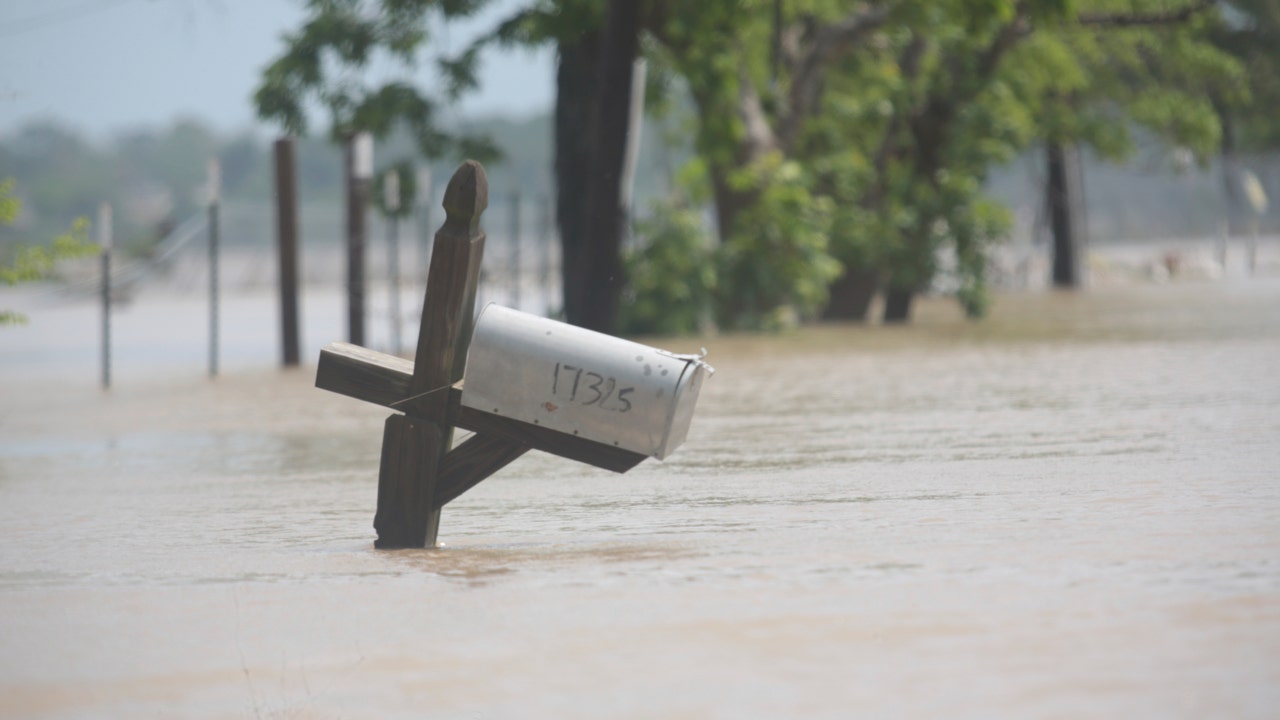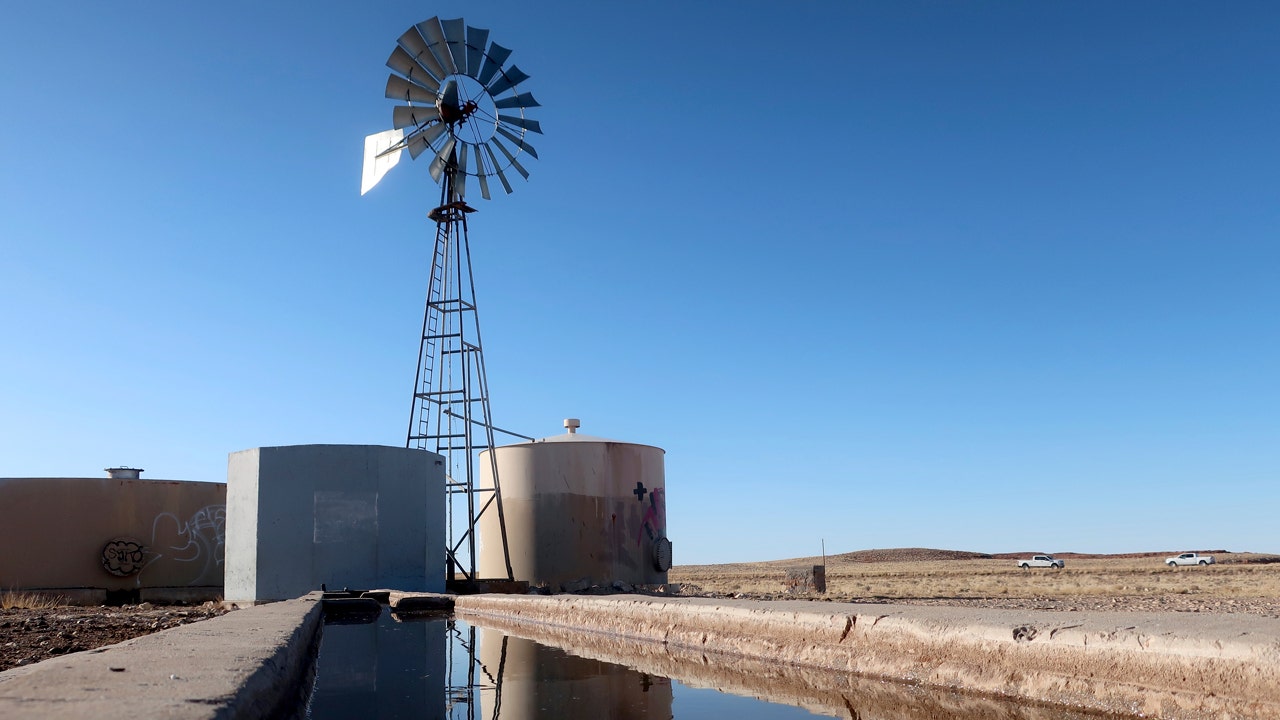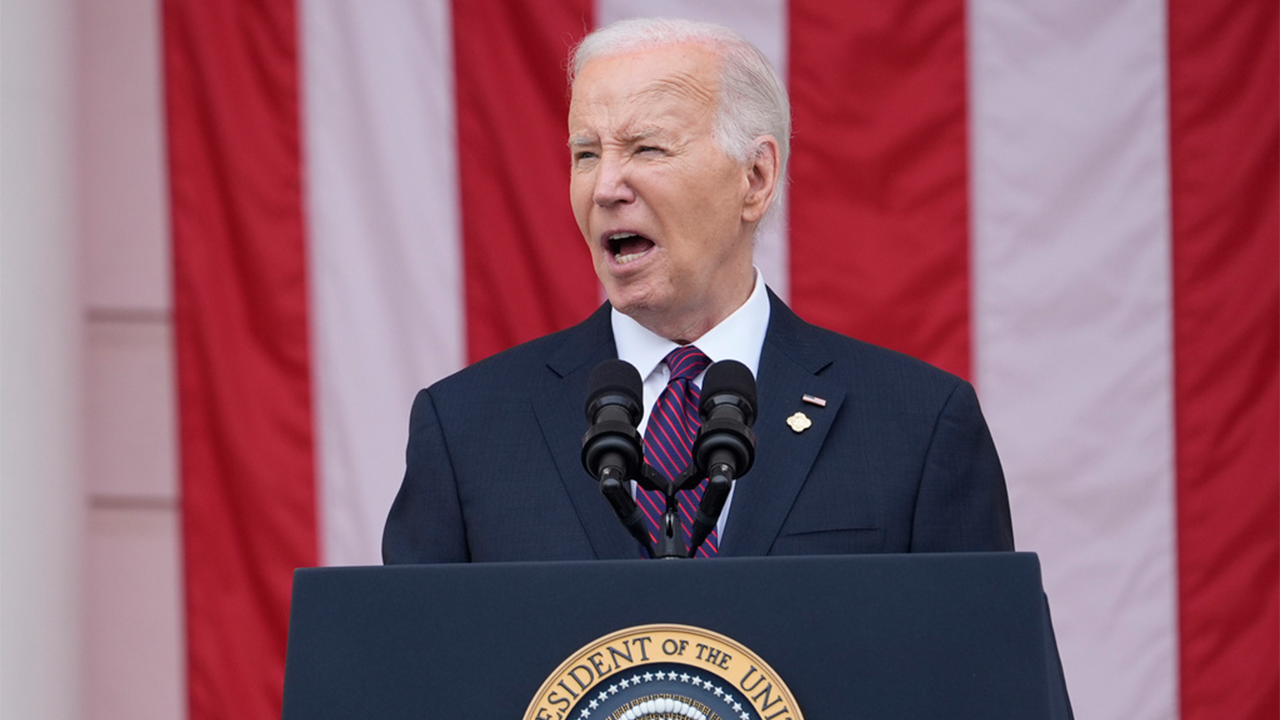Southwest
Floodwaters start receding around Houston area as recovery begins following rescues and evacuations

Floodwaters in the Houston area began to recede on Monday, allowing residents to begin returning to their homes and assess damages after days of heavy rainfall that pummeled the area and led to hundreds of rescues — including people who were stranded on rooftops.
Officials in Harris County, where Houston is located, reported no deaths or major injuries from the flooding. But in North Texas, a 4-year-old boy died after riding in a car that was swept away in fast waters, authorities said.
HEAVY RAINS OVER TEXAS HAVE LED TO WATER RESCUES, SCHOOL CANCELLATIONS AND EVACUATION ORDERS
After days of heavy rainfall in the Houston area and other parts of Southeast Texas, the forecast on Monday called for mainly sunny skies with a slight chance of showers.
“We can absolutely see the light at the end of the tunnel, and we’ve made it through the worst of this weather event,” Harris County Judge Lina Hidalgo, the county’s top elected official, told reporters Monday.
A mailbox is partially submerged on a flooded street in an unincorporated area in east Harris County near Houston on Sunday morning, May 5, 2024. The nearby San Jacinto River, overflowing due to heavy rainfall earlier this week, caused the flood waters. (AP Photo/Lekan Oyekanmi)
Areas near Lake Livingston, located northeast of Houston, received upwards of 23 inches (58 centimeters) of rain over the past week, National Weather Service meteorologist Jimmy Fowler said. Areas in northeastern Harris County, the nation’s third-largest county, had a range of between 6 inches (15 centimeters) to almost 17 inches (43 centimeters) of rain in that same period.
Hidalgo said 233 people and 186 pets had been rescued in Harris County over the last few days. Active rescues stopped Monday, and officials were transitioning from a response phase into recovery mode and cleanup, she said.
While many of the impacted neighborhoods and subdivisions along the San Jacinto River in Harris County were accessible on Monday, others remained cut off by flooded roadways.
Officials were still assessing how many homes were damaged.
“We’re a resilient community. I know we’ll continue to recover from this,” said Harris County Sheriff Ed Gonzalez.
At least five school districts around the Houston area were closed on Monday due to the flooding.
Houston is one of the most flood-prone metro areas in the country. Hurricane Harvey in 2017 dumped historic rainfall that flooded thousands of homes and resulted in more than 60,000 rescues.
Most of the city of Houston was not heavily impacted by last week’s rainfall, except for the neighborhood of Kingwood, where some homes and roads flooded.
Various counties and communities north and east of the Houston area also continued to recover on Monday.
“These folks have suffered much, people,” Trinity County Sheriff Woody Wallace said Sunday during a Facebook livestream as he rode a boat through a rural flooded neighborhood. Partially submerged cars and street signs were around him.
In Johnson County, south of Fort Worth, a 4-year-old boy died when he was swept away after the vehicle he was riding in became stuck in swift-moving water near the community of Lillian just before 2 a.m. Sunday, an official said. The Tarrant County medical examiner’s office said the cause of death of the child, who would have turned 5 later this month, was drowning.
Storms brought 9 inches (23 centimeters) of rain in a span of six to eight hours in some areas from central Texas to the Dallas-Fort Worth area, National Weather Service meteorologist Matt Stalley said.
Greg Moss, 68, stayed put in his recreational vehicle on Sunday after leaving his home in the community of Channelview in eastern Harris County near the San Jacinto River. A day earlier, he had packed up many of his belongings and left before the road to his home flooded.
“I would be stuck for four days,” Moss said. “So now at least I can go get something to eat.”
Read the full article from Here

Los Angeles, Ca
Baby mountain lion stalking Southern California neighborhood

A young mountain lion roaming a Thousand Oaks neighborhood has residents on alert, especially after it was captured on home surveillance cameras chasing a family’s house cat.
While the baby couguar may look cute at first glance, residents in the area quickly realized the small mountain lion is hungry and looking for food.
“I saw it and I looked again because we do have house cats go across the front door,” Thousand Oaks resident Kelly McGee told KTLA’s Carlos Saucedo. “I looked again and I was like, ‘No, the ears are round. That’s not a cat.’”
Kelly and Mark McGee spotted the cougar on their home’s motion activated cameras earlier this when it was on their front porch.
“It wasn’t full size, so we had to re-look at it and zoom into it and stuff and then we realized, ‘Oh my God, it’s a baby mountain lion,’” Mark explained.
Cameras at their neighbor’s home across the street also captured the young mountain lion as it was chasing after a cat and it’s unclear what happened to the wild cat’s prey.
“We hope it’s okay,” Kelly said. “We haven’t heard of any neighbors missing a cat yet, so hopefully he made it home.”
The McGee’s and their neighbors live near Los Padres trail, a wildlife preserve. So, residents in these foothills are used to seeing all sorts of animals, including coyotes who routinely visit homes in the area.
“We’ve been here since 1987,” Esther O’Connor told KTLA. “Basically, the only wildlife we’ve ever seen, up until I would say a couple of years ago, were birds and squirrels and racoons, but never a mountain lion.”
The recent cougar sightings have residents on edge, particularly those with small pets.
“They can jump the fence pretty easy and get in the backyard,” Mark explained. “We let our dogs out late. I always worry about that.”
It’s also unclear if this young mountain lion has any siblings, who are also out on the hunt.
“Just a little baby, but we haven’t seen mom yet on the prowl,” Kelly said. “It would be cool to see mom, but at the same time, it’d be a little scary.”
Experts say these sightings are a good reminder to secure your pets and stay vigilant.
Southwest
Native American tribes unanimously approve Colorado River water rights proposal that would cost Congress $5B

- The Navajo Nation Council has unanimously approved a proposed water rights settlement. The Navajo, Hopi and San Juan Southern Paiute tribes are seeking more than $5 billion as part of their settlement, more than any such agreement enacted by Congress.
- The Navajo Nation has one of the largest single outstanding claims in the Colorado River basin and has worked for generations to secure water deliveries for tribal communities.
- Nearly a third of homes in the Navajo Nation don’t have running water. Many homes on Hopi lands are similarly situated.
The Navajo Nation Council has signed off on a proposed settlement that would ensure water rights for its tribe and two others in the drought-stricken Southwest — a deal that could become the most expensive enacted by Congress.
The Navajo Nation has one of the largest single outstanding claims in the Colorado River basin. Delegates acknowledged the gravity of their vote Thursday and stood to applause after casting a unanimous vote. Many noted that the effort to secure water deliveries for tribal communities has spanned generations.
Council Speaker Crystalyne Curley and other officials stood outside the chamber in Window Rock, Arizona, under a clear blue sky as the wind whipped. She recalled learning about the fight over water rights in school when she was a girl.
BIDEN DOJ SIDES WITH NATIVE AMERICAN TRIBE IN COURT FILING RIPPING CANADIAN PIPELINE AS TRESPASSING
Momentous is how she described the day, before she put her pen to the legislation and nearby vehicles honked their horns in celebration.
“This is an opportunity to think 100 years ahead for our children,” said Curley, a mother and soon-to-be grandmother.
“The time is now and we have to make our footing for the future,” she continued.
A windmill draws water for livestock in Leupp, Arizona, on the Navajo Nation, on March 9, 2024. In a vote on May 23, 2024, the Navajo Nation Council unanimously approved a proposed water rights settlement that carries a price tag larger than any such agreement enacted by Congress. (AP Photo/Felicia Fonseca, File)
The San Juan Southern Paiute Tribal Council also voted to approve the settlement Thursday, while the Hopi tribe approved it earlier this week. Congress will have the final say.
For Hopi, the settlement is a path to ensuring a reliable water supply and infrastructure for the health, well-being and economic prosperity of the tribe for generations to come, Hopi said in a statement late Thursday.
“Most importantly, this settlement provides a way for Hopi to fulfill its covenant with Maasaw (guardian) to live as stewards of Hopitutskwa (Hopi land),” the statement read.
Congress has enacted nearly three dozen tribal water rights settlements across the U.S. over the last four decades and federal negotiation teams are working on another 22 agreements involving dozens of tribes. In this case, the Navajo, Hopi and San Juan Southern Paiute tribes are seeking more than $5 billion as part of their settlement.
About $1.75 billion of that would fund a pipeline from Lake Powell, one of the two largest reservoirs in the Colorado River system, on the Arizona-Utah border. The settlement would require the U.S. Bureau of Reclamation to complete the project by the end of 2040.
From there, water would be delivered to dozens of tribal communities in remote areas.
Nearly a third of homes in the Navajo Nation — spanning 27,000 square miles of Arizona, New Mexico and Utah — don’t have running water. Many homes on Hopi lands are similarly situated.
Navajo President Buu Nygren plans to sign the settlement legislation as soon as it hits his desk, likely Friday. He told The Associated Press it had been a long road to get everyone to the table and the next step will be knocking on the doors of Congress.
A century ago, tribes were left out of a landmark 1922 agreement that divided the Colorado River basin water among seven Western states. Now, the tribes are seeking water from a mix of sources: the Colorado River, the Little Colorado River, aquifers and washes on tribal lands in northeastern Arizona.
The latest settlement talks were driven in part by worsening impacts from climate change and demands on the river like those that have allowed Phoenix, Las Vegas and other desert cities to thrive. The Navajo, Hopi and San Juan Southern Paiute tribes are hoping to close the deal quickly under a Democratic administration in Arizona and with Joe Biden as president.
Without a settlement, the tribes would be at the mercy of courts. Already, the U.S. Supreme Court has ruled that the federal government is not bound by treaties with the Navajo Nation to secure water for the tribe. Navajo has the largest land base of any of the 574 federally recognized tribes and is second in population with more than 400,000 citizens.
A separate case that has played out over decades in Arizona over the Little Colorado River basin will likely result in far less water than the Navajo Nation says it needs because the tribe has to prove it has historically used the water. That’s hard to do when the tribe hasn’t had access to much of it, Navajo Attorney General Ethel Branch has said.
Arizona — situated in the Colorado River’s Lower Basin with California, Nevada and Mexico — is unique in that it also has an allocation in the Upper Basin. The state would get certainty in the amount of water available as it’s forced to cut back as the overall supply diminishes.
Navajo and Hopi, like other Arizona tribes, could be part of that solution if they secure the right to lease water within the state that could be delivered through a canal system that already serves metropolitan Tucson and Phoenix.
Arizona water officials have said the leasing authority is a key component of the settlement.
Read the full article from Here
Los Angeles, Ca
Carjacking suspect taken into custody after pursuit in Southern California

A driver suspected of carjacking a Toyota pickup truck Monday evening, who then led authorities in a pursuit has been taken into custody.
Officers with the Los Angeles Police Department’s Wilshire Division initiated the pursuit and chased the suspect into eastbound lanes of 10 Freeway through Crenshaw and then to the 110 and 405 Freeways, where officers from the California Highway Patrol took over.
The suspect remained on the 405 at moderate speeds of around 60 miles per hour when authorities successfully deployed a spike strip, taking out the passenger tires near Springdale Street.
The suspect eventually came to a stop in Huntington Beach, near Beach Boulevard, where he was not initially complying with officers’ commands to exit the vehicle.
Several CHP, using a shield, approached the suspect and took him into custody. The suspect later fought officers as they were attempting to put him into the back of a CHP cruiser.
Sky5 was overhead.
-

 Movie Reviews1 week ago
Movie Reviews1 week ago‘The Substance’ Review: An Excellent Demi Moore Helps Sustain Coralie Fargeat’s Stylish but Redundant Body Horror
-

 News1 week ago
News1 week agoVideo: A Student Protester Facing Disciplinary Action Has ‘No Regrets’
-

 Movie Reviews1 week ago
Movie Reviews1 week ago‘Rumours’ Review: Cate Blanchett and Alicia Vikander Play Clueless World Leaders in Guy Maddin’s Very Funny, Truly Silly Dark Comedy
-

 Movie Reviews1 week ago
Movie Reviews1 week ago‘Blue Sun Palace’ Review: An Intimate, Affecting and Dogma-Free Portrait of Chinese Immigrants in Working-Class New York
-

 Culture1 week ago
Culture1 week agoFrom Dairy Daddies to Trash Pandas: How branding creates fans for lower-league baseball teams
-

 World1 week ago
World1 week agoPanic in Bishkek: Why were Pakistani students attacked in Kyrgyzstan?
-

 Politics7 days ago
Politics7 days agoAnti-Israel agitators interrupt Blinken Senate testimony, hauled out by Capitol police
-

 World1 week ago
World1 week agoRussian court seizes two European banks’ assets amid Western sanctions















